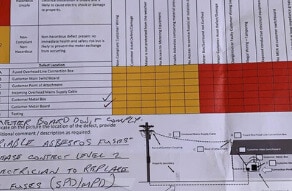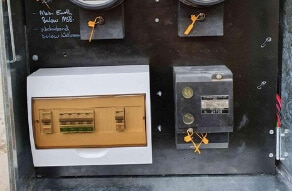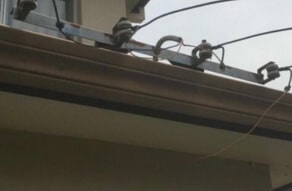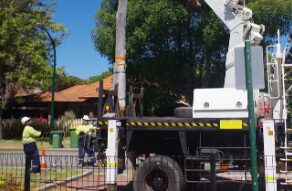Call us now
0439 823 190Which is better, overhead power lines or underground cables?
Posted on October 1, 2019

A common question we get all the time is which is better, overhead power lines or underground cables? This question often arises after a wild storm or hail damage, which has caused widespread electricity outages.
Answered simply.. There is no real difference in power and underground cables look a lot better and are safer. However, overhead power lines have a slightly longer lifespan and are more cost-effective on paper. This is mainly because they are up to 61% cheaper and their faults are easier to locate/repair by a level 2 electrician. There are a number of different individual variables that come into play such as location, population density, consumer preference and safety. This makes the answer to this question a lot less black and white than what it seems. It is also important to have a general understanding of the electrical grid as a whole.


What is the Electrical Grid?
The electric grid is a generic term for the network in which power is generated, transmitted and distributed to consumers. It is broadly made up of three key components, which are discussed below. To make things a bit easier, we have simpliflied these!
- Generation: Electricity is produced within generating plants. The Australian Energy Market Commission (AEMC) is a useful resource in locating the plants in which we consumer our electricity within Sydney.
- Transmission and Distribution: This is the infrastructure which enables electricity to be transported. This is where overhead power lines and underground cables come in typically through power substations, transformer boxes and consumer mains.
- Consumption: This is the household or commercial consumption of electricity which is then stored at the properties switchboard.
The electrical grid is an important element in weighing up the benefits between the two, as it determines accessibility. For instance, if there are large natural elements between certain areas, such as mountains and lakes. The transmission and distribution component becomes more complex.
Are Overhead Power Lines Good?
Overhead power lines are the large electrical private power poles you see on pretty much most streets. They come in two types which are timber and galvanised steel poles. From an electrician’s perspective, they are easier to modify and rerouted as the faults are easily identifiable. However, they are subjected to a lot more environmental hazards than their counterparts. Some typical examples that we encounter daily include: tree branches falling onto powerlines, vehicles driving into poles (A Sydney special), storm and wind activity, erosion and animal interference (poor birds and possums). As an overhead power line reaches maturity and the end of its running lifetime, they need to be upgraded and evaluated. This is where the decision to either transition to underground or stay overhead comes into question.
Private Power Pole Defects
A defective overhead power pole will eventually result in you receiving an electrical defect notice. The main reasons for you receiving this notice is that your electricity connection to the main network has been deemed unsafe by Ausgrid, Essential Energy and Endeavour Energy. You have up to 21-30 days to resolve your defect notice by contacting a private Level 2 ASP electrician, otherwise risk having power being turned off at your property. Specific defect issues that potentially may go wrong with a private power poles include:
- Point of attachment bracket defects
- Consumer main issues
- Private power pole replacement, repairs or installs
- Upgrading to 3 phase switchboards

Are Underground Powerlines Good?
Underground cables have become more popular and will continue to take over most streets and suburbs. We have already started to see this push in Sydney. Their aesthetic and their large elimination of environmental hazards makes them safer and attractive. These cables are self-contained underground and are barely noticeable. They are often better suited for highly populated areas, such as major CBDs and residential zones where congestion is a problem. The saved space can be better used for pedestrian crossings and public infrastructure. As well as adding to overall real estate attractiveness of an area.
However, like anything in life, there are drawbacks. Some major limitations of underground cables are the higher upfront costs of installs as they have to be electrically insulated underground. This offers the underground cables protection against moisture and corrosions. There can also be difficulty in locating faults. As the cables are embedded underground, if there is a major problem they may have to be resurfaced. However, this is unlikely as these cables are often brand new. Although they do have a relatively shorter life compared to overhead cables.
Is Underground Power Better Than Overhead Power?
Underground cables, in our professional opinion, are the best suited for modern living. Their aesthetically pleasing design and their large reduction of risk makes them a better candidate for electrical power. Although, they have their limitations. Such as, they are often more expensive and that they have a relatively shorter life. They will inevitably become more and more popular in the future, as the technology behind continues to improve. All new development subdivisions within populated areas in Sydney are now required to be built with underground cables. However, at the end of the day the decision to install overhead or underground simply comes down to your personal circumstances and what will work best for you.
What Are The Benefits Of Overhead & Underground Power?
OVERHEAD CABLES |
UNDERGROUND CABLES |
|
|---|---|---|
Construction |
Relatively easy to construct – 61% cheaper | Expensive |
Installation |
Straightforward | Difficult, requires digging |
Conductor Sizes |
Smaller conductors due to natural cooling | Larger conductors |
Repair/Maintenance |
Easier to spot and repair faults | Can be difficult depending on severity of problem. However, less likely to break |
Environmental Impact |
Intrusive environmental impact | More environmental benefits – reduced noise, loss of transmission and less wildlife damage |
Life Expectancy |
Longer life span | Shorter life span |
Safety |
Exposed to more risks – vegetation falling, animals, car crashes etc. | Safer – contained under ground |
Design |
Very noticeable, limits public land use | Barely notice – great for congested areas such as CBDs and residential zones. |

Our simple infographic hopefully will help you put into perspective the layout of overhead powerlines compared to underground power. Please contact if you have questions as our electricians can assist with the repairs and installations of both!
Professional Electricians Repairing & Installing Overhead & Underground Power Lines
If you are unsure about which option is right for you, contact us now. The Local Electrician is Sydney based and are 24 hr electricians. We have emergency electricians waiting on stand-by to service all your electrical needs. We are also ASP qualified level 2 electricians which enables us to safely and effectively handle all level 2 outages. Our technicians are also qualified to carry out any overhead or underground repair, replacement or installation within any Sydney suburb!
Our Level 2 Electrical Services
Lifetime Warranty on Workmanship and Labor
- Private Power Pole Installation: What Sydney Homeowners Need To Know - November 29, 2023
- Understanding Power Outages: When To Call a Level 2 Electrician - November 14, 2023
- Understanding Level 2 Electrical Needs: FAQs for Sydney Homeowners - October 7, 2023
Our Level 2 Local Electrical Services








